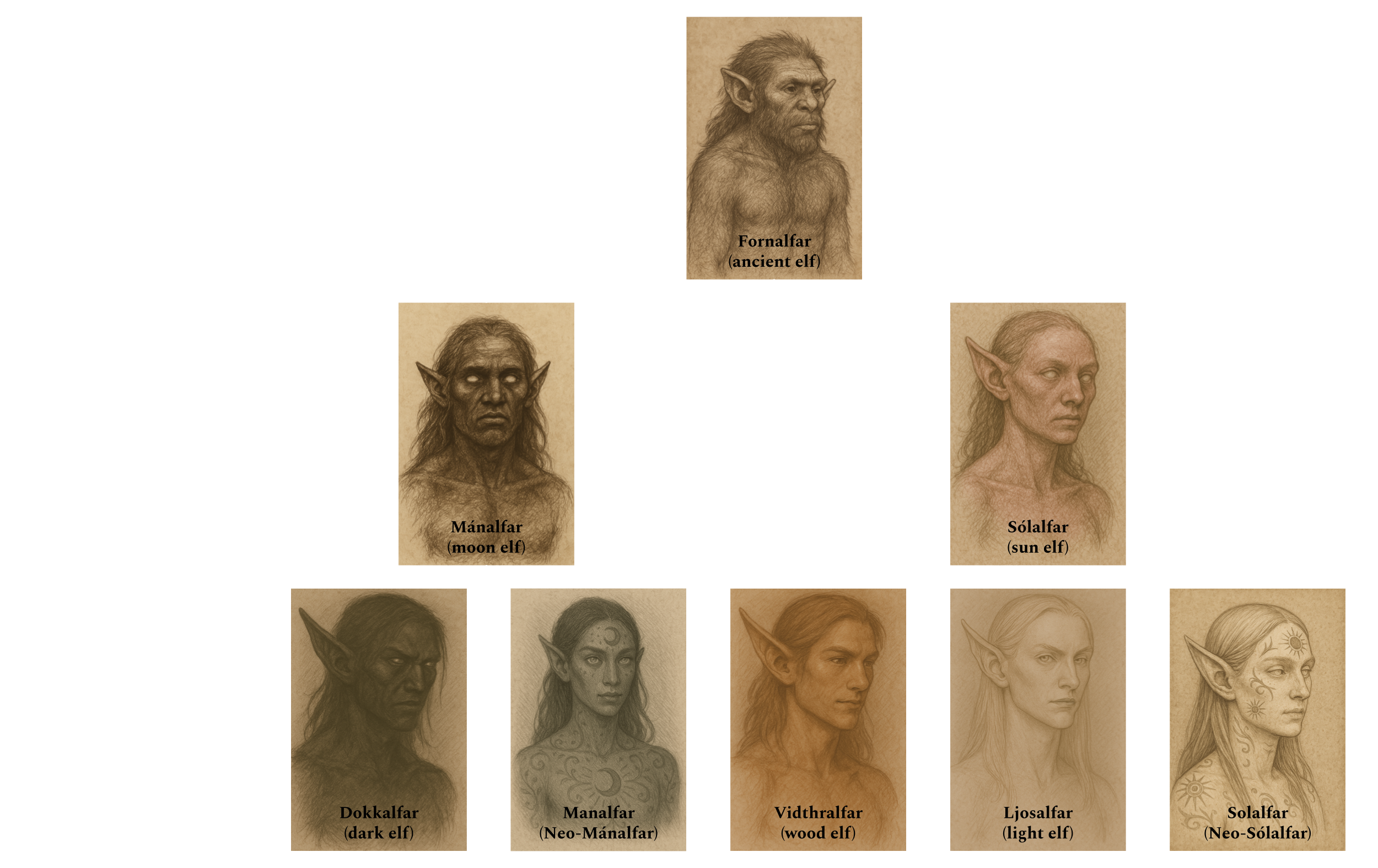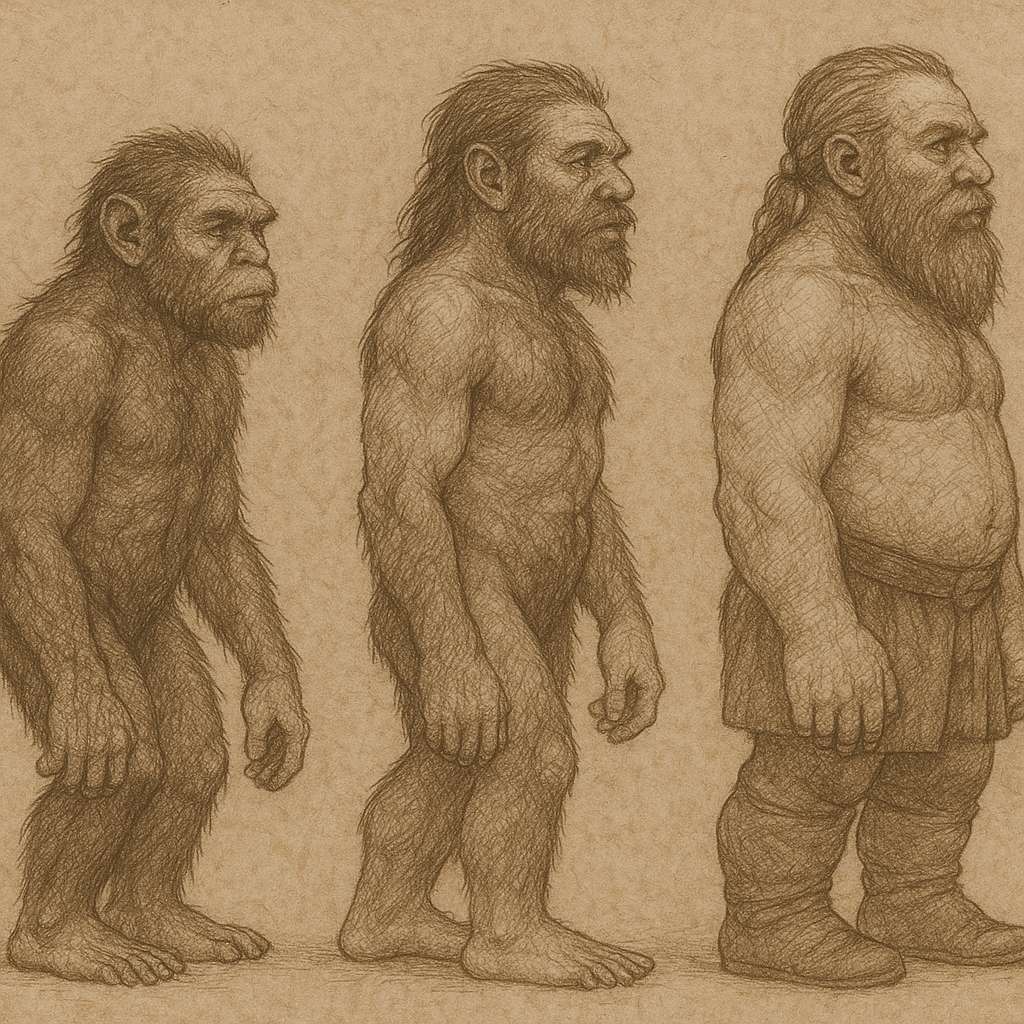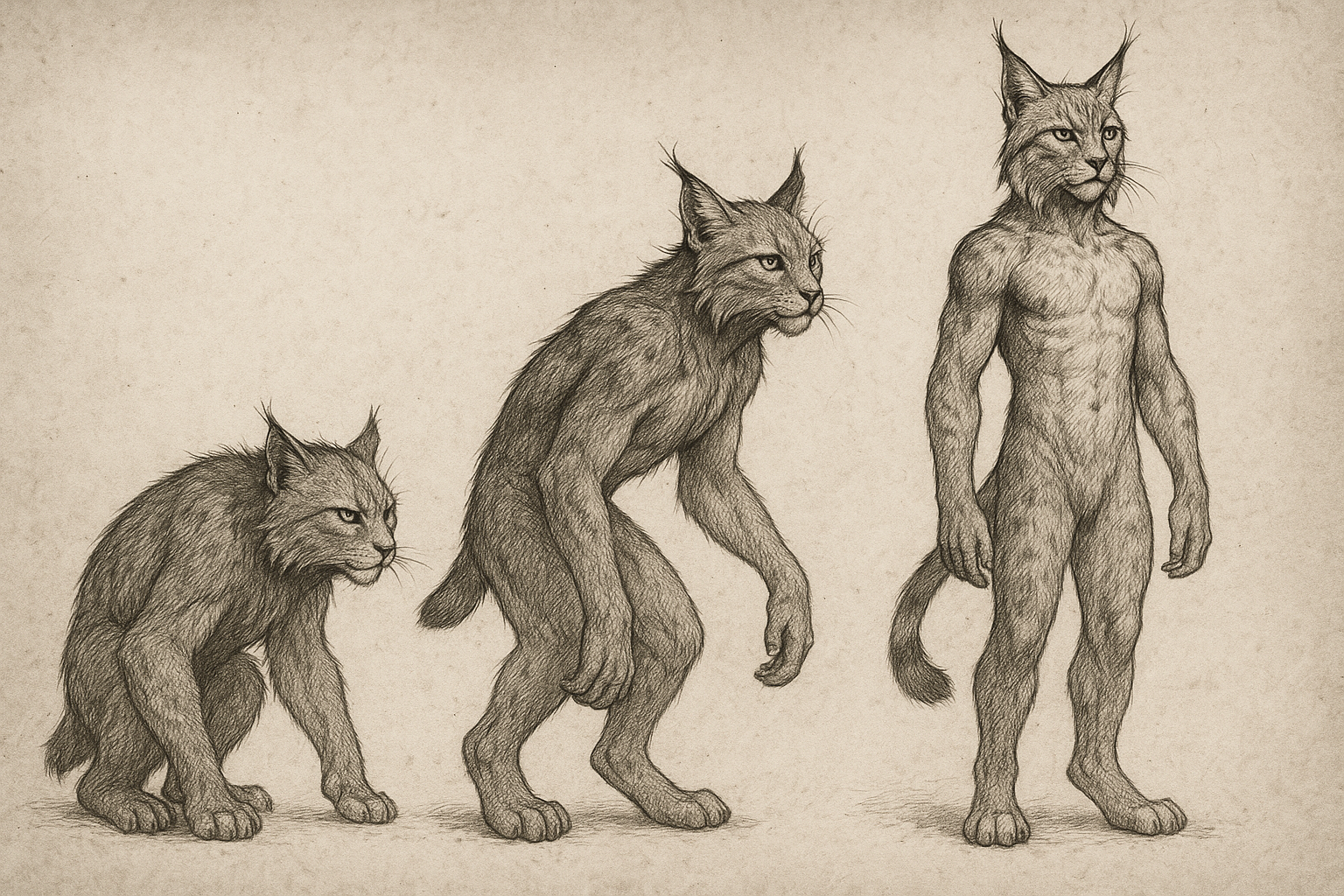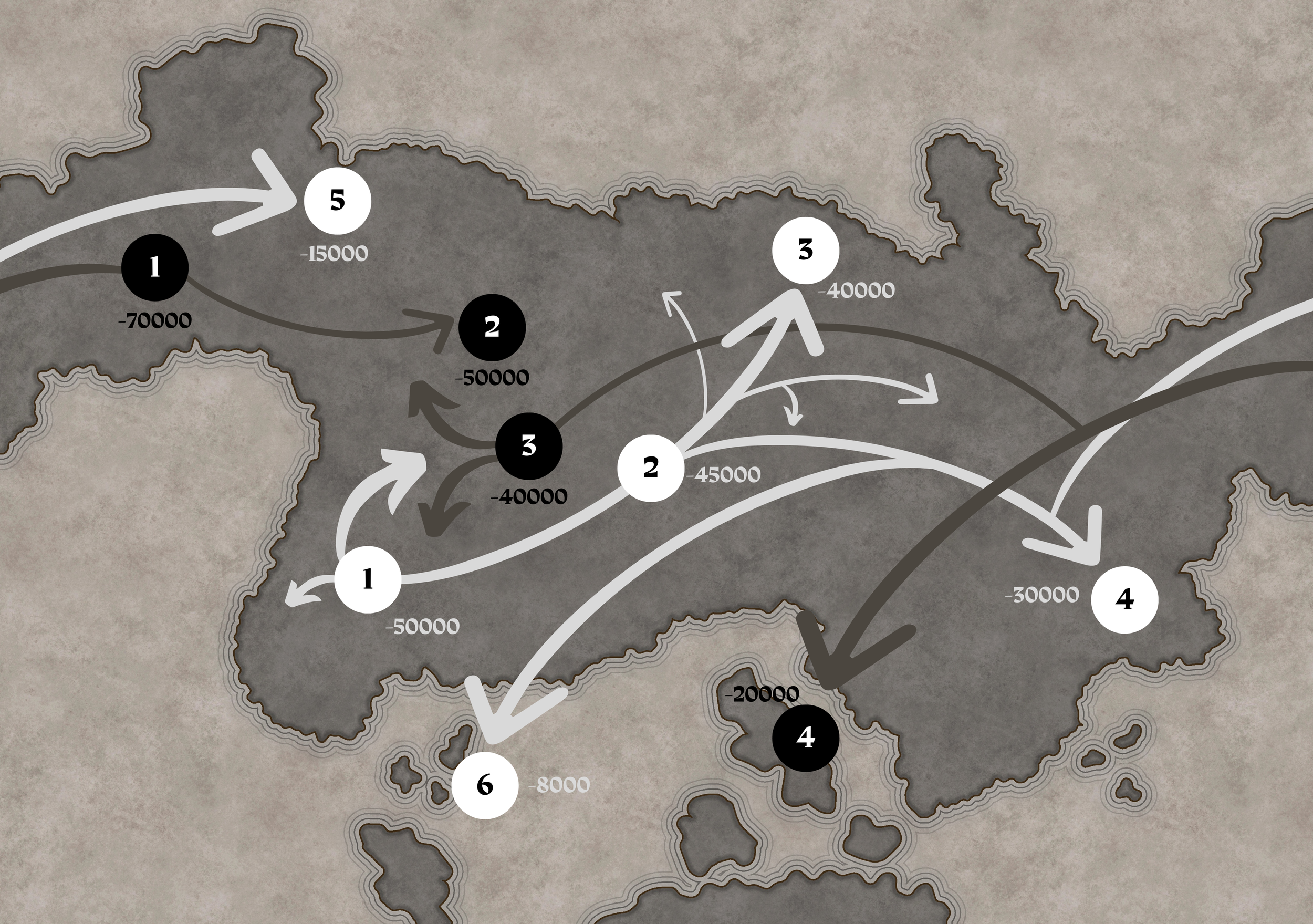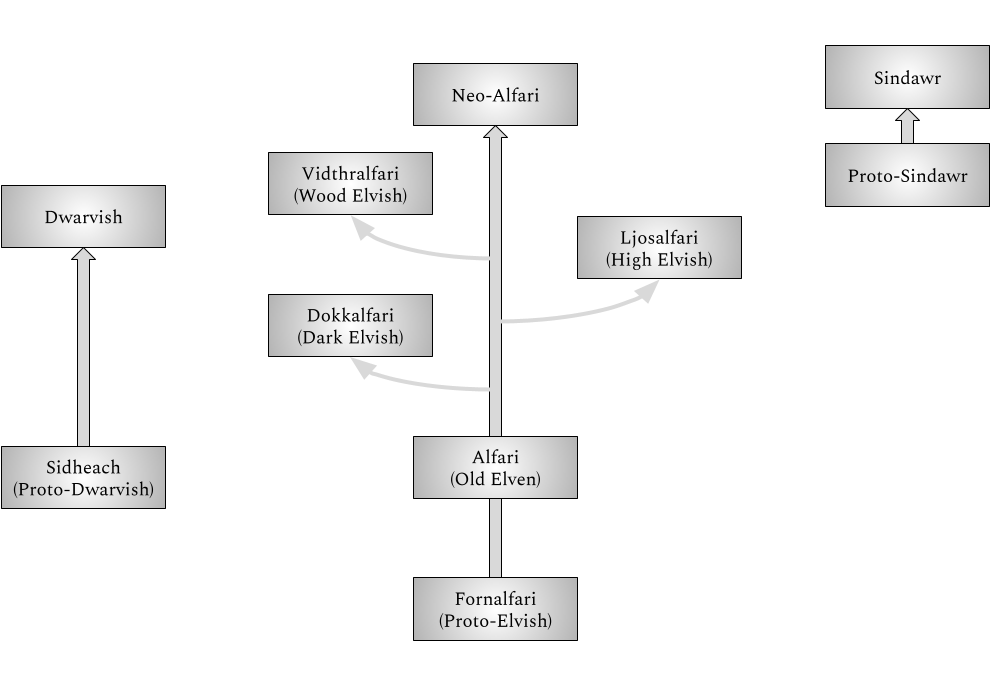Discover the History of Terra
Terra is approximately 4.2 billion years old. About 200 million years ago, the first continent formed, known as Sarvamsaha (“all-enduring”). In -6,000, the dragon-gods unleashed the Deluge, an event that drowned most of Terra and ruptured the mortal world.
Evolution
The widely accepted theory of a common ancestor for all sentient species was confirmed with the discovery of the remains of Uno. Uno belonged to a species of ape-like mammals predating any known recent primates inhabiting Terra.
Evidence of the Vidvamsa (“learned ones”) or Erudites, also referred to as the “Ancients”, was uncovered approximately 200,000 years ago through archaeological discoveries of tools and skeletal remains.
As their societies expanded, the Erudites gradually distanced themselves from the dragon-gods. What began as disputes turned into a global conflict, where the Erudites waged war against the gods, the gods eventually unleashing a deluge that drowned the continent.
Modern illustration of an Erudite
Sktech of Uno
It is hypothesised that Uno was chosen by the goddess Dracuuria to bear her essence and attain a state referred to as devatva (“godhood”), characterised by sentient thought and communication. The Erudites are believed to be the direct descendants of Uno, arising as the result of Dracuuria’s intervention.
Over tens of thousands of years, they underwent evolutionary development. The Erudites are credited with wielding the earliest known forms of magic and constructing civilisations of advanced architectural design and technological sophistication.
Elves
Foreseeing an eventual divergence between the Erudites and the dragon-gods, Dracuuria is believed to have selected the fornalfar (“ancient elf”) as her next evolutionary project. The fornalfar is regarded as a descendant of Uno.
Evolution tree of the elves
The fornalfar remained in seclusion until internal conflicts triggered a division. Interests shifted, and some fornalfar began to worship the sun while others venerated the moon. Due to the significant influence of environment and self-actualisation on elven genetics, this divergence resulted in the formation of two subspecies: the mánalfar (“moon elf”) and the sólalfar (“sun elf”).
Over the course of approximately 50,000 years, continued conflicts and separations led to further evolutionary changes and the emergence of additional subspecies. Mánalfar who migrated underground developed distinct characteristics, leading to their classification as dokkalfar (“dark elf”). Sólalfar who adapted to colder regions evolved fairer skin and higher cheekbones, becoming known as ljosalfar (“light elf”, although now also referred to as “high elf”).
Sólalfar who traveled south into woodlands and deserts developed traits now associated with the vidthralfar (“wood elf”). Both the mánalfar and sólalfar continued to evolve into newer forms over time.
Population movements influenced not only genetics but also traditions and language. The naming of subspecies derives from Old Elven.
Humans
Sketch of Primo
Primo is the name given to the hypothesized common ancestor of all humans. Believed to be another creation of Dracuuria, originating approximately 20,000 years after the fornalfar, Primo is considered a close relative of Uno, though not a direct descendant.
Genetic analyses suggest that Primo possessed adaptations favouring endurance, manual dexterity, and cognitive flexibility, traits that would later characterise humans.
Human evolution is strongly influenced by environmental factors, and migratory patterns led to significant diversification in physical traits, as well as in cultural traditions and language.
Dwarves
Evolutionary progression of Primulus
Primulus (“small Primo”) is considered the ancestor of the dwarves and a direct relative of Primo. Primulus is the final species selected by Dracuuria for advancement along the adaptive chain.
Dwarves evolved to become highly robust and extremely resistant to climatic extremes. They established civilisations deep beneath the mountains of Sarvamsaha.
Following the Deluge, the dwarven colony was largely spared, as they had already concentrated their settlements beneath the continent later known as the Reclining Drake.
Sithrax
Sketch of a modern sithrax (male)
Sketch of a modern sithrax (female)
For thousands of years, it was believed that the Sithrax (from an onomatopoeic hiss combined with “wrath”) were direct descendants of the dragon-gods. Recent evidence indicates that the Sithrax were, in fact, the result of genetic experimentation on humans conducted by the Erudites. They are believed to have emerged from genetic modifications performed approximately 10,000 years ago, designed to create biologically resilient war machines.
Human genetic material was merged with that of desert reptiles to produce a highly durable species characterised by an intense predatory drive. The Erudites ultimately concluded their experiment in warfare and bloodshed. However, unable to control the Sithrax, they cast them into the desert and contained them within the Barrier, a spherical force field erected around the region of Rallis.
Sindur
Evolutionary progression of Felis Major
The ancestor of the Sindur, Felis Major (“greater cat”), is believed to have roamed the deserts of Sarvamsaha approximately 30,000 years ago. The earliest evidence of the first sindurs date back to approximately -6,000, following the Deluge, on the island of Ailura. The prevailing theory is that the sindurs evolved naturally from feline predators. Being relatively recent in the evolutionary timeline, sindurs retain many of their ancestors’ instincts, survival traits, and predatory abilities.
Migrations
Migration paths of elves and humans throughout the Sarvamsaha
Elves and humans are the only races of Terra to have migrated extensively, influencing genetics, traditions, and language over the course of approximately 70,000 years.
In the figure above, the darker lines represent the migration paths of the elves, while the lighter lines represent the migration paths of humans. First, the darker lines are examined:
(1) -70,000 — The fornalfar (“ancient elf”), regarded as the common ancestor of all elves, migrates across Terra. Approximately 50,000 years ago, two subspecies emerge: the mánalfar (“moon elf”) and sólalfar (“sun elf”). Around 30,000 years ago, the sólalfar give rise to the ljosalfar (“light elf”), who remain in the original settlements.
(2) -50,000 — The sólalfar and mánalfar settle in mountainous regions. Subsequent conflicts drive the mánalfar underground, where they eventually diverge into the dokkalfar (“dark elf”) around 20,000 years ago.
(3) -40,000 — The sólalfar expand into forested regions and diversify. Genetic evidence indicates the appearance of the vidthralfar (“wood elf”) approximately 20,000 years ago.
(4) -20,000 — Neo-sólalfar and neo-mánalfar establish settlements in the southeastern isles.
Next, the lighter lines are examined:
(1) -50,000 — The earliest known human settlements, called the Banuelim (“children of the gods”), are established. A group migrates southwest, forming the Ukhokho (“ancestors”) tribe. Around 20,000 years ago, the Tazawo (“strong people”) tribe emerges.
(2) -45,000 — Human groups settle in mountainous areas, creating several high-altitude tribes. These tribes consolidate into the Bodh settlement approximately 10,000 years ago.
(3) -40,000 — Humans expand northward, forming the Proto-Eruditan population, which subsequently diversifies into multiple linguistically related tribes over millennia.
(4) -30,000 — Human groups settle along the eastern coast, in a region now referred to as Kanjuuna (“land of gentle cold”).
(5) -15,000 — Human populations establish themselves in the northwest, an area later known as Isqala (“place of fish”).
(6) -8,000 — Human groups settle in the southern isles, forming the Whakatere (“navigators”) tribe.
Linguistics
Evolution and population movements strongly influenced linguistics. Most cultural evidence of language were eradicated by the Deluge but archeological reconstructions have allowed for the establishment of linguistic history of the various languages of Terra.
The language tree of elves, dwarves, and sindurs
The oldest known language of the Post-Eruditan world is Fornalfari, a hypothesised proto-language spoken by the first elves. Fornalfari is believed to have been highly primitive, characterised by a limited vocabulary, predominantly monosyllabic words, heavy reliance on gestural communication, and a simple grammatical structure based largely on repetition, tone, and context.There are no written records of Fornalfari.
The same holds true for Sidheach, spoken by the early dwarves, and Proto-Sindawr, spoken by the sindurs. Both of these languages are believed to have been highly primitive.
Sidheach eventually evolved into the early dialects of Dwarvish known by approximately -4000. Although Dwarvish has continued to develop over time, its grammatical structures and core patterns still trace back to its earliest forms.
Proto-Sindawr gave rise to Sindawr around -1000. Uniquely, Sindawr is the only pre–Anno Varkadia language that has remained virtually unchanged, making it one of the oldest continuously spoken modern languages. The language incorporates meow-like intonations, purring undertones, trilled consonants, and variable pitch to convey meaning, mood, and intent. Sindawr relies on tonal shifts, tail-end vibrations, and subtle breathy vocalisations, making it highly expressive yet challenging for non-sindur speakers to reproduce accurately. Modern Sindawr does show limited but noticeable influence from neighbouring languages, such as Izityenic and Ghalizi.
Old Elven (Alfari) is believed to have been spoken globally around -10,000. As elven populations migrated and diverged genetically, they also underwent cultural and linguistic differentiation, branching into Dokkalfari for dark elves, Ljosalfari for high elves, and Vidthralfari for wood elves. Populations of manalfar and solalfar now speak a later evolution of Old Elven, referred to as Neo-Alfari.
Human language tree
Humans diversified significantly over time, and so did their languages. The root of all human languages is believed to be a hypothetical common ancestor from which all modern languages descend. The first recorded human language, and impressively still spoken today, is Ukhokho, characterised by a complex system of click consonants and melodic tonality.
Tazme developed at the cradle of humanity during the early stages of human evolution, alongside several “proto” languages considered to be groupings of tribal dialects spoken at that time. The Scriptures of the Old were originally written in primitive Bodhan and widely translated into multiple modern languages approximately two centuries later.
The Banuelic language represents an early form of Ghalizi, which was formalised with the establishment of the Ghaliz Empire. Similarly, Kanjuunic refers to a group of languages sharing a common root, spoken for thousands of years before being officially standardized into modern Kanjuunese in 500:AV.
Proto-Eruditan languages were heavily influenced by the activities of the Erudites, who cohabited and interacted extensively with early human populations. Indavi is an ancient language spoken in Inuskali, directly descended from the language of the Erudites. All Proto-Eruditan languages share similar roots and exhibit common grammatical structures, core vocabulary, and phonological patterns, suggesting descent from a unified ancestral language. Eruditan stands at the centre of this linguistic family and is widely recognised in scientific studies as a reference language.
Following the conquest of Tazman by Lutessia and subsequent unification with Bravoure, the Tazme language underwent significant Lutessian influence and is now classified as a member of the Proto-Eruditan family.
Due to the global dominance of Bretannia as a formidable naval and trading power, the most widely spoken second language among humans is Bretannic, now commonly referred to as the Common Tongue.



